By: Sarah Armstrong, Animal Care Technician for Humane Pennsylvania
So many people seem confused or disgusted when I tell them I have pet rats.
“You have what living in your house?!”
“They’ll give you the plague!”
“Aren’t they super vicious?”
I’ve heard it all.
Pet rats have been domesticated since the 18th century, so it is a wonder to me that many people still don’t realize they’re a common pet, let alone a GOOD pet. Walk into any pet store that sells small animals and you’re sure to find them amongst the guinea pigs and hamsters. They come in dozens of different colors, patterns, fur types, and varieties. Celebrities such as Michael Jackson, Jamie Lee Curtis, Clint Eastwood, and even Theodore Roosevelt have/had pet rats.
So why do rats have such a bad reputation? I think the reason many people see having rats as “icky” is due to their portrayal in media. In many movies where rats appear, they are the villains. Cartoon rats are angular and toothy, with snarling, vicious smiles, while mice are small, round, wide-eyed, and cute. Toy rats, popular around Halloween, are usually pitch black with grimy fur and red eyes. And then of course, there’s Western Society’s hatred of the wild Norway Rat, who’s lived alongside humans for centuries, following us wherever we (and our trash) go.
The people that recoil in horror when I tell them I have pet rats usually change their tune after they actually meet my rats. It’s hard to see something as a cartoonish, red-eyed monster when it’s intently licking your hand or gently taking treats from between your fingers. And as more people open their eyes and their hearts to the true nature of these intelligent little animals, more are adopting them as pets.
So, here are five reasons why rats make the best pets! 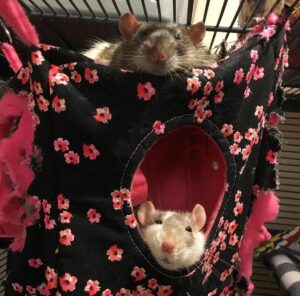
1. They’re “Pocket-Sized!”
Many apartments don’t allow for large pets like dogs or cats, but will make an exception for small caged pets like hamsters and guinea pigs. So, as long as you’re not letting your rats run around unsupervised to chew on the siding, landlords will often overlook them. While a dog, cat, or rabbit will use the whole house as their territory, rats will only take up as much room as their cage does. They’re also quiet (unless you get a particularly squeaky wheel) and won’t leave the apartment covered in fur, so any musophobic guests may not even realize they’re there! And, unlike a dog, you don’t need to expend too much energy to take them out for walks or play with them. A rat will simply be happy riding around on your shoulder or sitting with you while you watch TV.
2. They’re Friendly and Family-Oriented!
Rats are incredibly social animals. In the wild, rats live in large family groups, all caring for each other and working together, and as pets they are no different. They play together, store their food in a communal storage area, take care of their sick and elderly, and love to sleep in one big “rat pile.” Unlike the more solitary hamsters, rats are designed to be social.
Rats need to live with other rats, as a human can not provide the same type of companionship a fellow rat can, but they will still bond with their humans just as readily. I often marvel at how my rats seem to understand just how big I am compared to them, yet still treat me as if I’m just a giant rat. They will groom my hands with gentle licks and nibbles, pounce on my feet, and they are very good at communicating what they want. If my rats want to be picked up they will reach up to me, if they want me to come closer they’ll tug on my sleeves, if they want me to play they’ll pounce on and nibble at my hands, if they want to be left alone they’ll push my hand away, and if they’re very displeased with a situation they will squeak!
 They also know how to be gentle. Rats have very strong sharp teeth and, just like a dog or cat, can really do some damage if they want to! But their teeth are also extremely sensitive, and they use them to explore just as much as we use our hands. When a rat uses its teeth on something, it is immediately calculating what it’s biting into and how much pressure to use to avoid damaging it. I am consistently amazed at how my rats can so gently take a sesame seed out from between my fingers with their teeth, all while barely touching my skin.
They also know how to be gentle. Rats have very strong sharp teeth and, just like a dog or cat, can really do some damage if they want to! But their teeth are also extremely sensitive, and they use them to explore just as much as we use our hands. When a rat uses its teeth on something, it is immediately calculating what it’s biting into and how much pressure to use to avoid damaging it. I am consistently amazed at how my rats can so gently take a sesame seed out from between my fingers with their teeth, all while barely touching my skin.
Friendliness, communication, and gentleness are all great skills to have for an animal that lives in a big family in a tight space, and that’s why rats are so good at it!
3. They’re Super Smart!
Behavior experiments on lab rats have proven time and time again that rats are highly intelligent animals. While not only socially intelligent, they are also great problem solvers and thinkers. Studies have found rats to show empathy and regret, dream, reciprocate favors, strategize, and adapt quickly to new environments. In fact, the reason they’re so often used in experiments is they’re so neurologically, physiologically, and psychologically similar to humans!
As rats are highly food-motivated and love to learn new things, teaching them tricks is a great way to bond with your rats. Rats will usually quickly learn to come when called (mine certainly know to come when I open a bag of snack mix) but some people have trained their rats to fetch, jump through hoops, drive little scooters, pull drawstrings, and run obstacle courses! I rarely have the time to attempt all that anymore, but I do like to make sure my rats at least know “spin”, “up”, and “walk” (on their hind legs.) They love showing off these tricks for treats. Sometimes if my rats see me pull out a bag of treats they’ll come running and start doing every trick they know!
4. They’re Playful!
A side effect of being both sociable and smart is that rats love to play! Unlike a hamster, guinea pig, or even a mouse, rats love to engage in play simply for the joy of it. They will chase and tussle with each other, toys, and their humans. Studies have even found that rats will “laugh” when engaging in play (though this sound is too high-pitched for human ears.)
Rats are all individuals though, some may prefer to chase a feather on a string while others want to play “tag”, and some may just prefer to cuddle rather than be rowdy. Rats are also usually most playful as babies, winding down with age. Even so, if you want the “play factor” of a dog or cat compacted into a tiny little pocket pet, then rats are the pets for you.
5. They’re Clean!
Pet rats are domesticated. That means they’re a lot tamer and more comfortable around humans than their wild counterparts, such as the difference between a mangy coyote and a pampered pooch. Your average pet rat won’t be scampering around in the sewers and digging through the trash for scraps.
Rats actually are very clean animals. They spend a lot of time grooming themselves and each other (and their humans, too!) They like to be in a clean environment and you may even find rats creating a designated “trash area” and “poop area” in their cage, and they can be litter-trained. In fact, they consider humans to be pretty dirty themselves, and usually spend a lot of time cleaning themselves after having been handled (which I try not to be offended by.) As long as you keep their cage clean, they’ll be just as clean as a dog or cat, perhaps even more so since they won’t be outside playing in the dirt!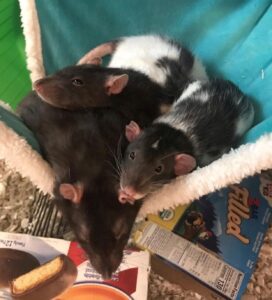
Cons to Owning Rats
So by this point you may be asking, “If rats are so great, why don’t more people have them? They’re still not as common a pet as a dog or cat!” Well, aside from the previously mentioned societal bias against them, they’re also not for everyone. For all their pros, there are also cons that may not make a rat the perfect pet for you.
Because rats are so intelligent and playful, they need a lot of space. Since it’s not very doable to let a rat safely free-roam around your house, they need a large cage, with multiple levels. A general rule of thumb is that each rat should have about two square feet of flat space to themselves. Depending on how many rats you have, that need for space can quickly add up! I have 4 rats right now; their cage has four levels and is taller than I am! I was lucky to find this cage for cheap, but if you want to have rats, the size and price of an adequate cage may be beyond your budget.
Since we’re on the topic of expenses, rats may seem like inexpensive pets at first, but you may find them costing much more than you bargained for when it comes to vet bills! Since rats are not cats or dogs, they are considered “exotics” and you need to find a vet trained in small mammal medicine. The cost of this specialized vet care can sometimes be more than even dog or cat vet bills. And rats will need a vet at least once in their lives as they are prone to respiratory issues and tumors, especially as they get older.
I find owning rats to be worth these expenses. I use CareCredit for their vet bills and budget for their needs. I buy Oxbow pellets in bulk so I save on food, use fleece as bedding so I save on bedding, and make toys for my rats (who tend to be more happy with a cardboard box than an expensive toy anyway… but isn’t that just the way with any pet?)
But the hardest part about having rats as pets is their lifespan. The average lifespan for a domestic rat is two and a half years. They start to slow down at around one and a half, and really show their age at two. I’ve heard of some rats living to be five or even nine, but I’ve had over forty rats in the last twelve years, and my longest-lived ones barely made it past three. For some, this can be too heartbreaking. To develop a bond with a highly intelligent, social animal only to have it pass away in a short time could be your deal-breaker when it comes to owning rats. I have met a few people who said they used to have rats but after they lost them they couldn’t go through it again.
And it is hard. Every time. But I believe that the love and joy that rats can give in that amount of time more than makes up for the heartbreak at the end. It also means that you’ll be more prepared for the next rat in need of a home. And there are always good rats in need of homes. If there aren’t any here at the Humane League, rat rescues are almost always at capacity, and you can usually find them on petfinder with a quick search.
Rats are fun, friendly, smart, and a drain on the wallet… but that’s what being a good pet is about, isn’t it? When I come home to see my rats all waiting to give me snuffly little kisses, I couldn’t imagine a more perfect pet.
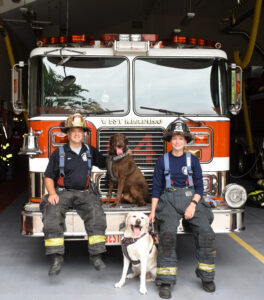 hazard because dogs, cats, mice, bunnies will sometimes chew on them. Unattended lit candles are not only dangerous on their own but can be easily knocked over by pets.
hazard because dogs, cats, mice, bunnies will sometimes chew on them. Unattended lit candles are not only dangerous on their own but can be easily knocked over by pets. A.G.: If you can’t get them out, DO NOT go back in to get them. Let the arriving responders know the last known location and a description of the animal.
A.G.: If you can’t get them out, DO NOT go back in to get them. Let the arriving responders know the last known location and a description of the animal.

 burns and/or trauma to the face, paws, and skin. Never use fireworks around your pets, as many types contain potentially toxic substances, including potassium nitrate, arsenic, and other heavy metals.
burns and/or trauma to the face, paws, and skin. Never use fireworks around your pets, as many types contain potentially toxic substances, including potassium nitrate, arsenic, and other heavy metals.
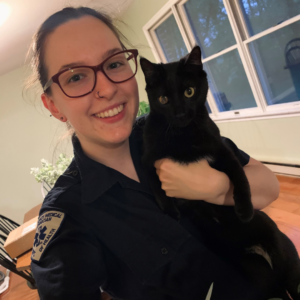
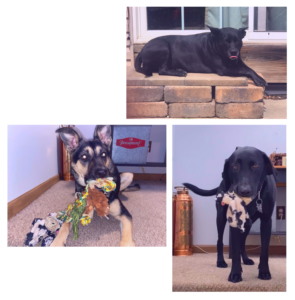 “Being part of the EMS life is harder than most can handle! You see people at perhaps the worst times in their lives — when they are extremely sick, injured, facing death, or even when they are at rock bottom. Most times the comfort you provide, besides the medicine and treatment, is all people need. When I come home from my shifts, it takes a while to unwind and clear my mind from everything that’s been encountered in my shift. I come home and before I can get the door open, my pups — Koda, Bella, and Hunter — are usually whining and crying because they can’t wait for me to come in!
“Being part of the EMS life is harder than most can handle! You see people at perhaps the worst times in their lives — when they are extremely sick, injured, facing death, or even when they are at rock bottom. Most times the comfort you provide, besides the medicine and treatment, is all people need. When I come home from my shifts, it takes a while to unwind and clear my mind from everything that’s been encountered in my shift. I come home and before I can get the door open, my pups — Koda, Bella, and Hunter — are usually whining and crying because they can’t wait for me to come in!
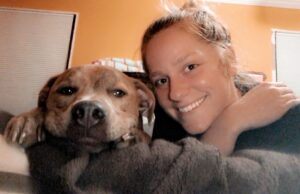
 started here and I had no experience. I worked in retail prior to coming here. I had pets growing up, but no experience with animal welfare, and she really molded me into what I am now. And of course, Leann. She has helped me grow so much, from working as a tech to now being in a managerial position. It’s something that I didn’t even know I could do, but she helped me grow and helped me make decisions that led to my continued growth within the organization.
started here and I had no experience. I worked in retail prior to coming here. I had pets growing up, but no experience with animal welfare, and she really molded me into what I am now. And of course, Leann. She has helped me grow so much, from working as a tech to now being in a managerial position. It’s something that I didn’t even know I could do, but she helped me grow and helped me make decisions that led to my continued growth within the organization. My favorite would have to be Vincenzo! He is an FIV (Feline Immunodeficiency Virus) positive cat that has been with us for a little while. He came to us after a caretaker outside of the shelter noticed that he had some pretty severe wounds and his eyes were not in the best condition. I really loved watching him come around. He was so shy when he first got here and now he just makes biscuits everywhere. I love him. He’s so sweet and, after months of medical care, he’s finally ready for adoption.
My favorite would have to be Vincenzo! He is an FIV (Feline Immunodeficiency Virus) positive cat that has been with us for a little while. He came to us after a caretaker outside of the shelter noticed that he had some pretty severe wounds and his eyes were not in the best condition. I really loved watching him come around. He was so shy when he first got here and now he just makes biscuits everywhere. I love him. He’s so sweet and, after months of medical care, he’s finally ready for adoption. The louder it got the more she started to shake. I placed her on a big fluffy comforter, opened her cage door, and placed her information card in the slip on the front of her cage door. She sat up, looked in the direction of the door, and ran outside. I made it a point to walk past her kennel several times that day to see if she was acclimating okay. Each time I saw her curled up in the outside part of her run, I walked around and placed a blanket on that side to make sure she remained comfortable. “You don’t want to lay on the hard cement, Anastasia.” She stood up and walked as far away from me as she could.
The louder it got the more she started to shake. I placed her on a big fluffy comforter, opened her cage door, and placed her information card in the slip on the front of her cage door. She sat up, looked in the direction of the door, and ran outside. I made it a point to walk past her kennel several times that day to see if she was acclimating okay. Each time I saw her curled up in the outside part of her run, I walked around and placed a blanket on that side to make sure she remained comfortable. “You don’t want to lay on the hard cement, Anastasia.” She stood up and walked as far away from me as she could. think of the vital role animal care volunteers play as fairly simple, but as a community-supported charitable organization, volunteers serve in so many other ways. Our volunteer board of directors helps guide the mission and vision of Humane Pennsylvania and ensures stewardship of our donor resources. Event and fundraising volunteers help connect Humane Pennsylvania with people in the community who want to support our work. Professional service providers — ranging from attorneys to mechanics to builders — help us stretch our dollars so we can put the most into care for the animals. There is no part of our work that is not touched and improved through volunteer efforts and I am truly grateful to work with all of these dedicated animal lovers!”
think of the vital role animal care volunteers play as fairly simple, but as a community-supported charitable organization, volunteers serve in so many other ways. Our volunteer board of directors helps guide the mission and vision of Humane Pennsylvania and ensures stewardship of our donor resources. Event and fundraising volunteers help connect Humane Pennsylvania with people in the community who want to support our work. Professional service providers — ranging from attorneys to mechanics to builders — help us stretch our dollars so we can put the most into care for the animals. There is no part of our work that is not touched and improved through volunteer efforts and I am truly grateful to work with all of these dedicated animal lovers!”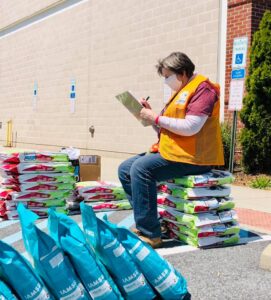 “
“ caregivers as part of the Healthy Pets Initiative (HPI). A vital function of the facility is a tactile presence to verified clients who stop by Spike’s Pet Pantry as they pick up supplemental pet food and supplies, learn about our services, and come to trust us as their “pet partner”. Volunteers keep our program running efficiently by performing regular, timely data entry, sort/prepare pet food/supplies on pantry days and pick up pet food/supply donations throughout the community. We also rely on them to help us unload and distribute tractor-trailers full of donations from the Greater Good Affiliate Program and other high volume donors so we can share resources with other animal welfare organizations, including state/county animal response teams. Volunteers graciously extend their existing relationships with valuable, pet-friendly individuals and businesses to encourage, create and maintain local engagement and support of HPI events (community vaccination/microchip clinics, etc.) and programming. When existing, more fortunate pet owners truly understand our mission to improve local pet care and ownership habits, they become an integral part of achieving our goal to be the best community for pets and their owners. For these reasons, we are beyond grateful for the volunteers that continue to help make Humane Pennsylvania an amazing organization for animals and animal caretakers.”
caregivers as part of the Healthy Pets Initiative (HPI). A vital function of the facility is a tactile presence to verified clients who stop by Spike’s Pet Pantry as they pick up supplemental pet food and supplies, learn about our services, and come to trust us as their “pet partner”. Volunteers keep our program running efficiently by performing regular, timely data entry, sort/prepare pet food/supplies on pantry days and pick up pet food/supply donations throughout the community. We also rely on them to help us unload and distribute tractor-trailers full of donations from the Greater Good Affiliate Program and other high volume donors so we can share resources with other animal welfare organizations, including state/county animal response teams. Volunteers graciously extend their existing relationships with valuable, pet-friendly individuals and businesses to encourage, create and maintain local engagement and support of HPI events (community vaccination/microchip clinics, etc.) and programming. When existing, more fortunate pet owners truly understand our mission to improve local pet care and ownership habits, they become an integral part of achieving our goal to be the best community for pets and their owners. For these reasons, we are beyond grateful for the volunteers that continue to help make Humane Pennsylvania an amazing organization for animals and animal caretakers.”  Pennsylvania is a hot spot for tick borne disease. Some species of ticks in our area frequently transmit Lyme, Anaplasma, and Ehrlichia. Infrequently seen tick borne diseases in our area include Babesiosis and Rocky Mountain Spotted Fever. The same ticks that transmit tick borne disease to dogs can transmit the disease to humans as well. A tick needs to be feeding for over 18 hours before it transmits disease. It is important to use a reputable product that acts quickly to kill a tick before it can spread disease. Some products will repel ticks as well. Checking animals for ticks after they come in from outside is advisable. There are many great products on the market with a variety of routes of administration. These routes include a chewable that last one to three months, collars that last up to 8 months and once monthly topical applications. Choosing the right one will depend on your pet and your preference. Products made to be effective against ticks are also effective against fleas. It is extremely important to make sure a product that is effective against ticks is specifically labeled for use in cats.
Pennsylvania is a hot spot for tick borne disease. Some species of ticks in our area frequently transmit Lyme, Anaplasma, and Ehrlichia. Infrequently seen tick borne diseases in our area include Babesiosis and Rocky Mountain Spotted Fever. The same ticks that transmit tick borne disease to dogs can transmit the disease to humans as well. A tick needs to be feeding for over 18 hours before it transmits disease. It is important to use a reputable product that acts quickly to kill a tick before it can spread disease. Some products will repel ticks as well. Checking animals for ticks after they come in from outside is advisable. There are many great products on the market with a variety of routes of administration. These routes include a chewable that last one to three months, collars that last up to 8 months and once monthly topical applications. Choosing the right one will depend on your pet and your preference. Products made to be effective against ticks are also effective against fleas. It is extremely important to make sure a product that is effective against ticks is specifically labeled for use in cats. AND outside of our pets’ bodies. Fleas are a common cause of skin disease, allergies and intestinal parasites for dogs and cats. They are contagious external parasites that can readily jump from animal to animal or can be carried by people into a home as they jump on our clothing. Wild animals coming into back yards where our pets roam is another way a yard can be a source of fleas. Once a flea is observed it is not sufficient to bathe once and call your problem resolved. A flea treatment needs to be used for a minimum of 3 months to get rid of an infestation. This length of time is due to the life cycle of the flea. Fleas can live in an environment without a blood meal for over 3 months. Flea dips and shampoos are not recommended due to their harsh ingredients. Flea dips do not help rid the animal of an infestation because pupae and eggs are already in the environment. Bathing with a gentle shampoo made for pets is a better option for removing adult fleas. A quality chewable or topical application for a minimum of 3 months is important treatment and prevention against future fleas. Because fleas are so contagious, all pets in a household need to be treated concurrently. Fleas carry diseases such as tapeworms, and Bartonella most commonly. Not all products that are effective against fleas are effective against ticks. Cats can have particular sensitivity to certain ingredients in low quality flea products, which should be avoided.
AND outside of our pets’ bodies. Fleas are a common cause of skin disease, allergies and intestinal parasites for dogs and cats. They are contagious external parasites that can readily jump from animal to animal or can be carried by people into a home as they jump on our clothing. Wild animals coming into back yards where our pets roam is another way a yard can be a source of fleas. Once a flea is observed it is not sufficient to bathe once and call your problem resolved. A flea treatment needs to be used for a minimum of 3 months to get rid of an infestation. This length of time is due to the life cycle of the flea. Fleas can live in an environment without a blood meal for over 3 months. Flea dips and shampoos are not recommended due to their harsh ingredients. Flea dips do not help rid the animal of an infestation because pupae and eggs are already in the environment. Bathing with a gentle shampoo made for pets is a better option for removing adult fleas. A quality chewable or topical application for a minimum of 3 months is important treatment and prevention against future fleas. Because fleas are so contagious, all pets in a household need to be treated concurrently. Fleas carry diseases such as tapeworms, and Bartonella most commonly. Not all products that are effective against fleas are effective against ticks. Cats can have particular sensitivity to certain ingredients in low quality flea products, which should be avoided.
 They also know how to be gentle. Rats have very strong sharp teeth and, just like a dog or cat, can really do some damage if they want to! But their teeth are also extremely sensitive, and they use them to explore just as much as we use our hands. When a rat uses its teeth on something, it is immediately calculating what it’s biting into and how much pressure to use to avoid damaging it. I am consistently amazed at how my rats can so gently take a sesame seed out from between my fingers with their teeth, all while barely touching my skin.
They also know how to be gentle. Rats have very strong sharp teeth and, just like a dog or cat, can really do some damage if they want to! But their teeth are also extremely sensitive, and they use them to explore just as much as we use our hands. When a rat uses its teeth on something, it is immediately calculating what it’s biting into and how much pressure to use to avoid damaging it. I am consistently amazed at how my rats can so gently take a sesame seed out from between my fingers with their teeth, all while barely touching my skin.

 fees to garner the attention from the public in hopes of increasing their adoptions. They are typically held on weekends, but some are during the week. They can last anywhere from a day to even a week or month. While these events are generally held on site at the shelter there are some that are held off site. The shelter will tie in a theme like holidays, big events (like the start of school), current events or movies, etc. to help draw attention and make the event more fun. Fundraising plays a huge part to cover costs to hold the event and cover the adoption costs. If you are interested in sponsoring one of our adoption events you can contact our Director of Development, Lauren Henderson, at
fees to garner the attention from the public in hopes of increasing their adoptions. They are typically held on weekends, but some are during the week. They can last anywhere from a day to even a week or month. While these events are generally held on site at the shelter there are some that are held off site. The shelter will tie in a theme like holidays, big events (like the start of school), current events or movies, etc. to help draw attention and make the event more fun. Fundraising plays a huge part to cover costs to hold the event and cover the adoption costs. If you are interested in sponsoring one of our adoption events you can contact our Director of Development, Lauren Henderson, at 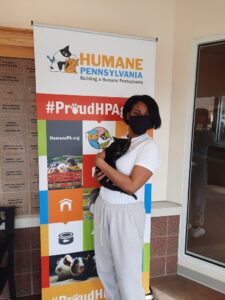 Be patient and expect to wait a little longer when coming to the shelter during a promotion. There may be lines or more traffic than normal. Especially with current restrictions on the number of people allowed inside our shelter at one time due to the pandemic you may need to wait outside or in your car throughout parts of the process.
Be patient and expect to wait a little longer when coming to the shelter during a promotion. There may be lines or more traffic than normal. Especially with current restrictions on the number of people allowed inside our shelter at one time due to the pandemic you may need to wait outside or in your car throughout parts of the process.